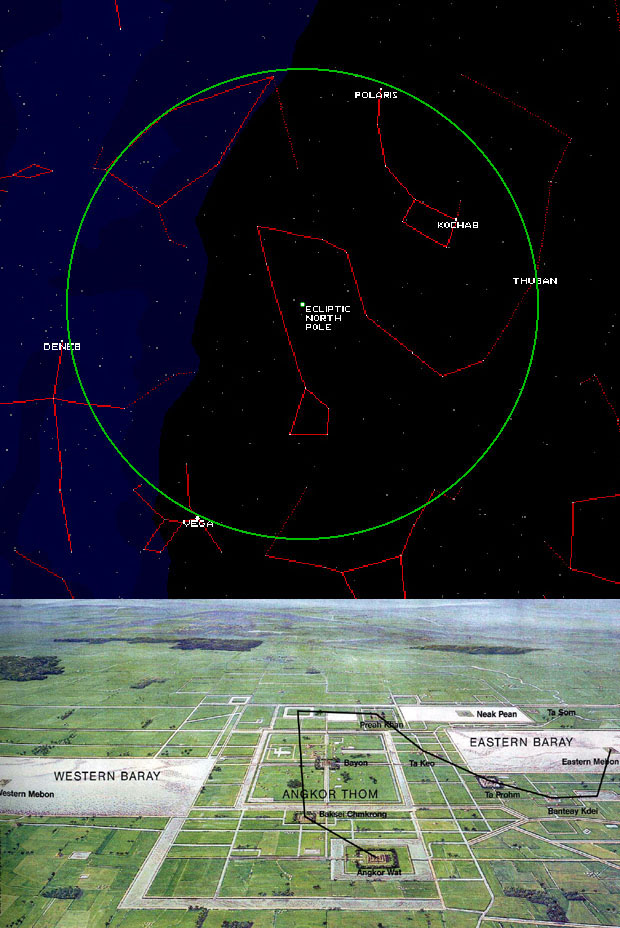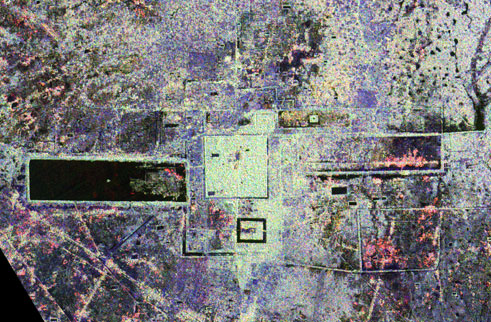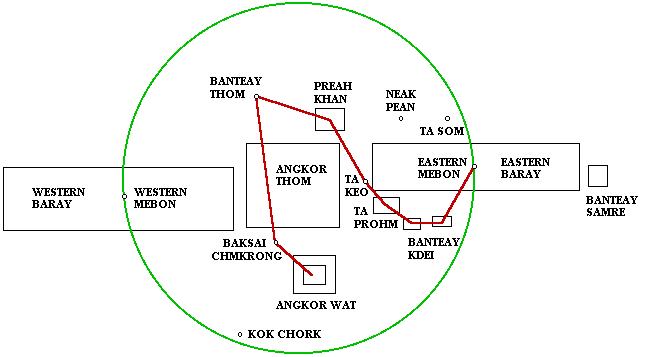Post by brillbilly on Mar 21, 2011 0:31:57 GMT 10

There are two great complexes of ancient temples in Southeast Asia, one at Bagan in Burma, the other at Angkor in Cambodia. The temples of Angkor, built by the Khmer civilization between 802 and 1220 AD, represent one of humankind's most astonishing and enduring architectural achievements. From Angkor the Khmer kings ruled over a vast domain that reached from Vietnam to China to the Bay of Bengal. The structures one sees at Angkor today, more than 100 stone temples in all, are the surviving remains of a grand religious, social and administrative metropolis whose other buildings - palaces, public buildings, and houses - were built of wood and have long since decayed and disappeared.

Alternative scholars, however, believe the geographical location of the Angkor complex and the arrangement of its temples was based on a planet-spanning sacred geography from archaic times. Using computer simulations, it has been shown that the ground plan of the Angkor complex – the terrestrial placement of its principal temples - mirrors the stars in the constellation of Draco at the time of spring equinox in 10,500 BC. While the date of this astronomical alignment is far earlier than any known construction at Angkor, it appears that its purpose was to architecturally mirror the heavens in order to assist in the harmonization of the earth and the stars. Both the layout of the Angkor temples and the iconographic nature of much its sculpture, particularly the asuras (‘demons’) and devas (‘deities’) are also intended to indicate the celestial phenomenon of the precession of the equinoxes and the slow transition from one astrological age to another.
In 1998 Graham Hancock and John Grigsby showed a correlation between the temples around Angkor Thom and the constellation of Draco. The diagram above shows the path of the celestial north pole around the ecliptic north pole, over an illustration of the main temples around Angkor Thom. On the ground, the location of Angkor Thom matches the location of the ecliptic north pole in the sky. West Mebon, East Mebon and Ta Som have the same spatial relationship to Angkor Thom that Deneb, Thuban and Kochab have to the ecliptic north pole.
The movement of the celestial pole is another aspect of the 25,776 year cycle known as the precession of the equinoxes. Because Angkor is in the tropics, the northern stars are low on the northern horizon. In the present era Polaris is close to the celestial north pole. When Draco is in alignment with the Angkor temples, it is below Polaris and below the horizon. During it's nightly rotation around the celestial north pole, when Draco is above Polaris and visible from Angkor, it is upside down in relation to the Angkor temples. In 11,500 B.C. Vega was the northern polestar and Draco aligned with the Angkor temples above Vega and above the horizon. Vega is the brightest star in the northern sky and it is by far the brightest northern polestar. Canopus is by far the brightest star along the celestial south pole and the second brightest star in the sky, after Sirius. Canopus and Vega were both polestars around the same time, approximately 13,500 years ago.
The illustration above suggests that the area north of Angkor is cleared, as it may have been when the temples were constructed, but today the area is mostly jungle. Satellite images like the one below have been used to locate temples around Angkor. This image shows what appears to be temple ruins to the northeast of Angkor Thom in the correct relative position and distance to represent Polaris.

At the temple of Phnom Bakheng there are 108 surrounding towers. The number 108, considered sacred in both Hindu and Buddhist cosmologies, is the sum of 72 plus 36 (36 being ½ of 72). The number 72 is a primary number in the sequence of numbers linked to the earth’s axial precession, which causes the apparent alteration in the position of the constellations over the period of 25,920 years, or one degree every 72 years. Another mysterious fact about the Angkor complex is its location 72 degrees of longitude east of the Pyramids of Giza. The temples of Bakong, Prah Ko and Prei Monli at Roluos, south of the main Angkor complex, are situated in relation to each other in such a way that they mirror the three stars in the Corona Borealis as they appeared at dawn on the spring equinox in 10,500 BC. It is interesting to note that the Corona Borealis would not have been visible from these temples during the 10th and 11th centuries when they were constructed.
Angkor Wat, built during the early years of the 12th century by Suryavaram II, honors the Hindu god Vishnu and is a symbolic representation of Hindu cosmology. Consisting of an enormous temple symbolizing the mythic Mt. Meru, its five inter-nested rectangular walls and moats represent chains of mountains and the cosmic ocean. The short dimensions of the vast compound are precisely aligned along a north-south axis, while the east-west axis has been deliberately diverted 0.75 degrees south of east and north of west, seemingly in order to give observers a three day anticipation of the spring equinox.


Unlike other temples at Angkor, Ta Prohm has been left as it was found, preserved as an example of what a tropical forest will do to an architectural monument when the protective hands of humans are withdrawn. Ta Prohm's walls, roofs, chambers and courtyards have been sufficiently repaired to stop further deterioration, and the inner sanctuary has been cleared of bushes and thick undergrowth, but the temple has been left in the stranglehold of trees. Having planted themselves centuries ago, the tree's serpentine roots pry apart the ancient stones and their immense trunks straddle the once bustling Buddhist temple. Built in the later part of the 12th century by Jayavarman VII, Ta Prohm is the terrestrial counterpart of the star Eta Draconis the Draco constellation.
www.earthportals.com/Portal_Messenger/draco.html
;)Cambodia has many hidden secrets




 Happy New Years Everybody!!!
Happy New Years Everybody!!!
